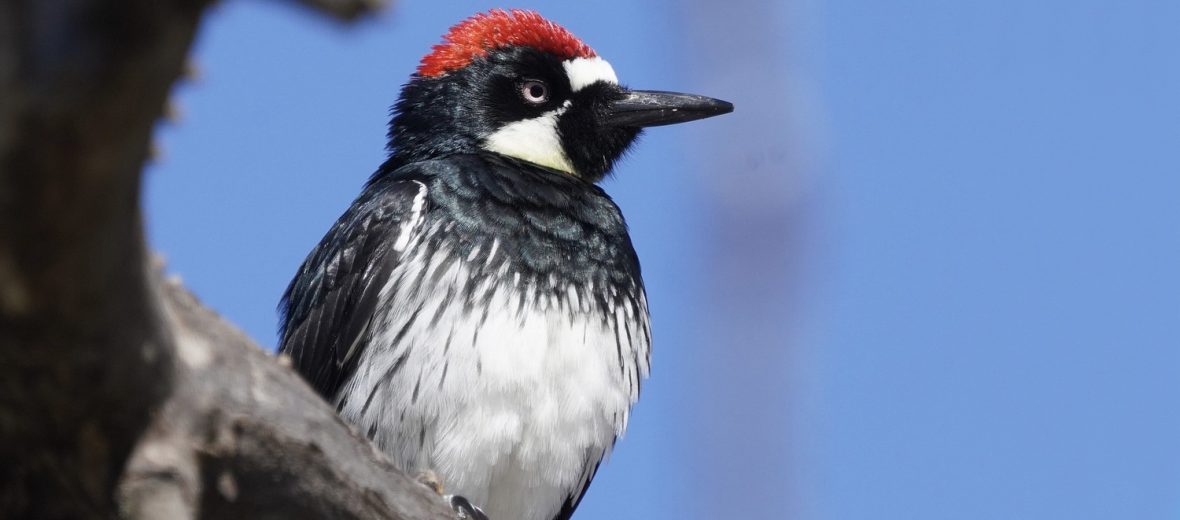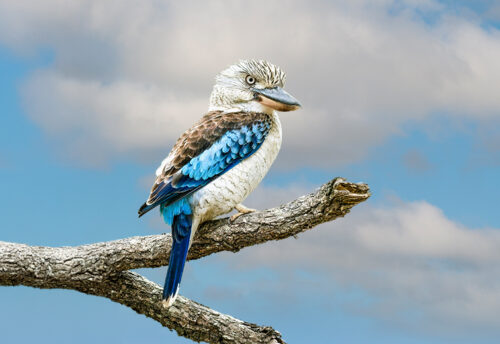
The acorn woodpecker can be found in Canada, United States, Mexico, Central America, and South America. They prefer oaks, oak-pine canyons, open oak groves near the coastline, mixed forests, and foothill habitats. These critter’s numbers are increasing throughout their range. There are approximately 7,500,000 wild individuals, to date. They also don’t face any substantial treats. Therefore, they are listed as Least Concern by the IUCN.
First the Stats…
Scientific name: Melanerpes formicivorus
Weight: Up to 3 ounces
Length: Up to 8.3 inches
Wingspan: Up to 17 inches
Lifespan: Up to 17+ years
Now on to the Facts!
1.) A group of woodpeckers is called a drumming, descent, descension, fall, or gatling.
2.) These woodpeckers have a complex social structure. The drummings will raise young, gather and cache (store) food reserves, and guard said caches from intruders, like Western scrub jays and Steller’s jays.
3.) They will create granaries, aka acorn trees, by drilling a series of holes in various objects, such as telephone poles, dead trees and branches, and even in wooden buildings. They then store their collection of acorns in said holes.
4.) Sometimes, they will also drill into the thicker bark of larger living trees too. This doesn’t seem to cause any known problems for the trees though.
5.) The acorn holes and subsequent acorns, are always placed above the snow line, for easier retrieval.
But wait, there’s more on the acorn woodpecker!
6.) As the acorns dry and shrink, they are moved to smaller holes, for storage.
7.) These omnivores (eat plant and animal matter) will eat acorns, fruit, nuts, seeds, drill holes in living trees and their drink sap, and they will also eat insects. Sometimes, they will also feast on other bird’s eggs.
Did you know…?
The force of each peck can be more than 20 times stronger than what can cause a concussion in a human! Moving their heads an average of up to 15 mph, they can peck up to 12,000 times a day!
8.) Besides drumming, these critters will also communicate with a call that sounds like they are laughing.
9.) Acorn woodpeckers vary from being monogamous (mate for life) to breeding collectives. A breeding collective is where offspring will be cared for not only by their parents but by other group members, typically called helpers.
10.) The collectives will sometimes have a polygynandrous lifestyle (multiple breeding partners for males and females).
But wait, there’s more on the acorn woodpecker!
11.) Some adult woodpeckers will remain in their parent’s nest and assist in raising the next generation of acorn woodpeckers.
12.) In descents with more than 1 breeding female, the females will place their eggs into a solo nesting orifice.
Did you know…?
Using their superb hearing, these birds will locate the source of moving grubs inside the bark of trees and drill in the best locations to extract said tasty treats.
13.) Typically, a female will destroy any eggs currently in the nest before she starts to lay hers. However, once she starts laying her eggs, she will cease the destruction of the existing eggs.
14.) Up to 5 eggs are laid and hatch in up to 11 days.
15.) Chicks are born altricial (blind and helpless).
16.) The sharp-shinned hawk is the primary predator of acorn woodpeckers.
Now a Short Acorn Woodpecker Video!
Be sure to share & comment below! Also, check out the Critter Science YouTube channel. Videos added regularly!
Want to suggest a critter for me to write about? Let me know here.



